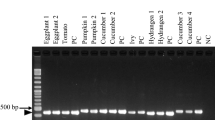Abstract
Strawberry (Fragaria (×) ananassa) plants exhibiting leaf lesions consistent with angular leaf spot (ALS, caused by Xanthomonas fragariae Kennedy and King 1962) were identified in the Queensland strawberry germplasm at Bundeberg in May 2010. Water suspensions of bacterial ooze tested positive using a previously described primer set. However, the slow growth rate of X. fragariae and the presence of a fast-growing, non-pathogenic, undescribed Xanthomonas species presented problems that were overcome by dilution plating and DNA sequence analysis. Sequencing of the gyrB locus of putative colonies of X. fragariae indicated 100% sequence similarity to other X. fragariae isolates. A new set of diagnostic primers for X. fragariae based on the gyrB locus is presented.



Similar content being viewed by others
References
Barionovi D, Scortichini M (2006) Assessment of integron gene cassette arrays in strains of Xanthomonas fragariae and X. arboricola pvs. fragariae and pruni. J PlantPathol 88:279–284
Bradbury JF (1986) Xanthomonas fragariae. In: Guide to plant pathogenic bacteria. CAB International Mycological Institute: Kew, UK. pp. 250–251
Brody JR, Calhoun ES, Gallmeier E, Creavalle TD, Kern SE (2004) Ultra-fast high-resolution agarose electrophoresis of DNA and RNA using low-molarity conductive media. Biotechniques 37:598–602
Dowson WJ (1939) On the systematic position and generic names of the gram negative bacterial plant pathogens. Zentr Bakteriol Parasitenk Abt II 100:177–193
Gibbs A, Armstrong J, Mackenzie AM, Weiller GF (1998) The GPRIME package: computer programs for identifying the best regions of aligned genes to target in nucleic acid hybridisation-based diagnostic tests, and their use with plant viruses. J Virol Meth 74:67–76
Gillings MR, Fahy PC, Bradley J (1998) Identification of Xanthomonas fragariae, the cause of an outbreak of angular leaf spot on strawberry in South Australia, and comparison with the cause of previous outbreaks in New South Wales and New Zealand. Australas Plant Pathol 27:97–103
Gillings MR, Holley MP, Stokes HW, Holmes AJ (2005) Integrons in Xanthomonas: a source of species genome diversity. Proc Natl Acad Sci 102:4419–4424
Hayward AC (1960) A method for characterizing Pseudomonas solanacearum. Nature 186:4054–4056
Janse JD, Rossi MP, Gorkink RFJ, Derks JHJ, Swings J, Janssens D, Scortichini M (2001) Bacterial leaf blight of strawberry (Fragaria (x) ananassa) caused by a pathovar of Xanthomonas arboricola, not similar to Xanthomonas fragariae Kennedy & King. Description of the causal organism as Xanthomonas arboricola pv. fragariae (pv. nov., comb. nov.). Plant Pathol 50:653–665
Kelman A (1954) The relationship of pathogenicity in Pseudomonas solanacearum to colony appearance on the tetrazolium medium. Phytopathology 44:693–695
Kennedy BW, King TH (1962) Angular leaf spot of strawberry caused by Xanthomonas fragariae sp. nov. Phytopathology 52:873–875
King EO, Ward MK, Raney DE (1954) Two simple media for the demonstration of pyocyanin and fluorescein. J Lab Clin Med 44:301–307
Koike H (1965) The aluminium-cap method for testing sugarcane varieties against leaf scald disease. Phytopathology 55:317–319
Lane DJ (1991) 16S/23S rRNA sequencing. In: Stackebrandt E, Goodfellow M (eds) Nucleic acid technologies in bacterial systematics. Wiley, London, pp 115–117
McGechan JK, Fahy PC (1976) Angular leaf spot of strawberry, Xanthomonas fragariae: first record of its occurrence in Australia and attempts to eradicate the disease. Aust Plant Pathol Soc Newslett 5:57–59
Parkinson N, Aritua V, Heeney J, Cowie C, Bew J, Stead D (2007) Phylogenetic analysis of Xanthomonas species by comparison of partial gyrase B gene sequences. Int J Syst Evol Microbiol 57:2881–2887
Parkinson N, Cowie C, Heeney J, Stead D (2009) Phylogenetic structure of Xanthomonas determined by comparison of gyrB sequences. Int J Syst Evol Microbiol 59:264–274
Pooler MR, Ritchie DF, Hartung JS (1996) Genetic relationships among strains of Xanthomonas fragariae based on random amplified polymorphic DNA PCR, repetitive extragenic palindromic PCR, and enterobacterial repetitive intergenic consensus PCR data and generation of multiplexed PCR primers useful for the identification of this phytopathogen. Appl Environ Microbiol 62:3121–3127
Roberts PD, Jones JB, Chandler CK, Stall RE, Berger RD (1996) Survival of Xanthomonas fragariae on strawberry in summer nurseries in Florida detected by specific primers and nested polymerase chain reaction. Plant Dis 80:1283–1288
Scortichini M, Rossi MP (2003) Genetic diversity of Xanthomonas arboricola pv. fragariae strains and comparison with some other X. arboricola pathovars using repetitive PCR genomic fingerprinting. J Phytopathol 151:113–119
Skerman VBD, McGowan V, Sneath PHA (1980) Approved lists of bacterial names. Int J Syst Bacteriol 30:225–420
Stöger A, Barionovi D, Calzolari A, Gozzi R, Ruppitsch W, Scortichini M (2008) Genetic variability of Xanthomonas fragariae strains obtained from field outbreaks and culture collections as revealed by repetitive-sequence and AFLP. J PlantPathol 90:469–473
Thompson JD, Gibson TJ, Plewniak F, Jeanmougin F, Higgins DG (1997) The ClustalX windows interface: flexible strategies for multiple sequence alignment aided by quality analysis tools. Nucleic Acids Res 24:4876–4882
Vauterin L, Yang P, Alvarez A, Takikawa Y, Roth DA, Vidaver AK, Stall RE, Kersters K, Swings J (1996) Identification of non-pathogenic Xanthomonas strains associated with plants. Syst Appl Microbiol 19:96–105
Wilson EE, Zeitoun FM, Fredrickson DL (1967) Bacterial phloem canker, a new disease of Persian walnut trees. Phytopathology 57:618–621
Young JM, Dye DW, Bradbury JF, Panagopoulos CG, Robbs CF (1978) A proposed nomenclature and classification for plant pathogenic bacteria. NZ J Agric Res 21:153–177
Acknowledgements
The authors wish to acknowledge Biosecurity Queensland for operational funding and Dr. Suzy Perry for logistical support, Dr. Jo Luck and Ramez Aldaoud (Victoria DPI) for discussion, Dr. Michael Priest (NSW I&I, Orange), for supplying deactivated cultures of the previous Australian incursions, as well as Natalia Peres and Teresa Seijo (University of Florida, USA), for supplying reference DNA for comparative purposes. We would also like to thank Stephanie Villiers and Julie Harris for critically reviewing the manuscript.
Author information
Authors and Affiliations
Corresponding author
Rights and permissions
About this article
Cite this article
Young, A.J., Marney, T.S., Herrington, M. et al. Outbreak of angular leaf spot, caused by Xanthomonas fragariae, in a Queensland strawberry germplasm collection. Australasian Plant Pathol. 40, 286–292 (2011). https://doi.org/10.1007/s13313-011-0045-y
Received:
Accepted:
Published:
Issue Date:
DOI: https://doi.org/10.1007/s13313-011-0045-y




